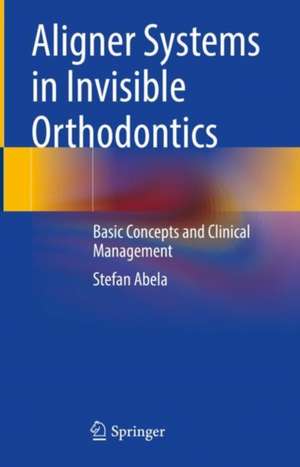Aligner Systems in Invisible Orthodontics: Basic Concepts and Clinical Management
Autor Stefan Abelaen Limba Engleză Hardback – mai 2024
This comprehensive step-by-step guide on aligner systems is a must have for both dental undergraduate and postgraduate dental students as well as for fully practising clinicians who want to deepen their knowledge in this innovative technique.
Preț: 1035.55 lei
Preț vechi: 1090.06 lei
-5% Nou
Puncte Express: 1553
Preț estimativ în valută:
198.16€ • 207.31$ • 164.61£
198.16€ • 207.31$ • 164.61£
Carte disponibilă
Livrare economică 13-27 martie
Preluare comenzi: 021 569.72.76
Specificații
ISBN-13: 9783031492037
ISBN-10: 303149203X
Ilustrații: XXIV, 193 p. 46 illus., 43 illus. in color.
Dimensiuni: 155 x 235 mm
Greutate: 0.53 kg
Ediția:2024
Editura: Springer International Publishing
Colecția Springer
Locul publicării:Cham, Switzerland
ISBN-10: 303149203X
Ilustrații: XXIV, 193 p. 46 illus., 43 illus. in color.
Dimensiuni: 155 x 235 mm
Greutate: 0.53 kg
Ediția:2024
Editura: Springer International Publishing
Colecția Springer
Locul publicării:Cham, Switzerland
Cuprins
Introduction.- Part I. Basic Concepts and Materials.- Chapter 1. General Aligner Concepts.- Chapter 2. Types of Aligner Systems Available.- Chapter 3. Aligner Treatment Process.- Chapter 4. Biomechanics with Aligner Treatment.- Part II. Clinical Management of Malocclusions.- Chapter 5. Navigating through the software.- Chapter 6. Clinical Management of Class I Cases.- Chapter 7. Clinical Management of Class II division 1 Cases.- Chapter 8. Clinical Management of Class II division 2 Cases.- Chapter 9. Clinical Management of Class III Cases.- Chapter 10. Clinical Management of Anterior Open Bite Cases.- Chapter 11. Clinical Management of Interceptive and Teenage Cases.- Chapter 12. Clinical Management of Surgical Cases.- Chapter 13. Clinical Management of Hybrid approaches with Aligners and Fixed Appliances, Sectional Lingual Appliances and Mini-Implants.- Part III. Clinical Tips and Techniques to Aligner Therapy.- Chapter 14. Limitations of Aligner Applications.-Chapter 15. Overcoming aligners’ Limitations.- Chapter 16. Patient Motivation for Long-term Compliance for Complex Treatments.- Chapter 17. 3D Software Planning Considerations for Crown-Root Movements.- Chapter 18. Clinical Tips for Treatment and Finishing.- Part IV. Technological Apps to aid Aligner Therapy.- Chapter 19. Aligner-Related Apps.- Part V. Evidence-based Aligner Therapy.- Chapter 20. Scientific Evidence of Aligner Treatment.
Notă biografică
Dr Stefan Abela is a specialist in Orthodontics and is registered on the General Dental Council (GDC) specialist list. Stefan has undergone training in various specialties including restorative dentistry, paediatric dentistry, oral medicine and complex oral and maxillofacial surgery including the management of facial trauma as well as study for his post graduate exams for membership into the Royal College of Surgeons of England. Stefan then embarked on his three year, full time specialist training in orthodontics in Cambridge, Norwich and Guy’s and St Thomas’ Hospital, London, gaining a Master in Science degree at King’s College London in 2011. He qualified as a specialist in orthodontics, gaining the Membership in Orthodontics at The Royal College of Surgeons of Edinburgh. He further his studies by gaining a Fellowship with The Royal College of Surgeons Of Edinburhg and he is currently the Head of Orthodontics at Norfolk and Norwich University Teaching Hospital NHS Foundation Trust in the United Kingdom. He is the Chief Execute Officer of two independent practices.
Stefan has carried out various research projects. He practises evidence-based dentistry and instills the same type practice in his teaching practises. He is heavily involved in teaching trainee dental surgeons undergoing specialisation in the UK national specialization programme. Additionally, he is also involved in teaching dental and orthodontic nurses. He has also written and published numerous articles in internationally peer-reviewed journals. Stefan is also an active member of the European Orthodontics Society, and The Higher Education Academy.
Stefan has carried out various research projects. He practises evidence-based dentistry and instills the same type practice in his teaching practises. He is heavily involved in teaching trainee dental surgeons undergoing specialisation in the UK national specialization programme. Additionally, he is also involved in teaching dental and orthodontic nurses. He has also written and published numerous articles in internationally peer-reviewed journals. Stefan is also an active member of the European Orthodontics Society, and The Higher Education Academy.
Textul de pe ultima copertă
This richly illustrated book describes the processes, techniques and biomechanics involved in providing aligner treatment for different types of malocclusions. It opens with an overview of the material characteristics and the basic concepts of aligner therapy including topics like biocompatibility and intraoral deterioration. The main part of the book is dedicated to the various types of aligners, the methods used in their application and the practical aspects of delivery. It is structured based on the type of malocclusion being managed giving the reader a systematic pattern and a practical way of progressing through the book. The book closes with a discussion of the scientific data available.
This comprehensive step-by-step guide on aligner systems is a must have for both dental undergraduate and postgraduate dental students as well as for fully practising clinicians who want to deepen their knowledge in this innovative technique.
This comprehensive step-by-step guide on aligner systems is a must have for both dental undergraduate and postgraduate dental students as well as for fully practising clinicians who want to deepen their knowledge in this innovative technique.
Caracteristici
Explains the basic concept of aligner systems Describes the clinical management of the different types of malocclusions with aligner systems Discusses scientific data and evidence-based approaches in aligner treatment
